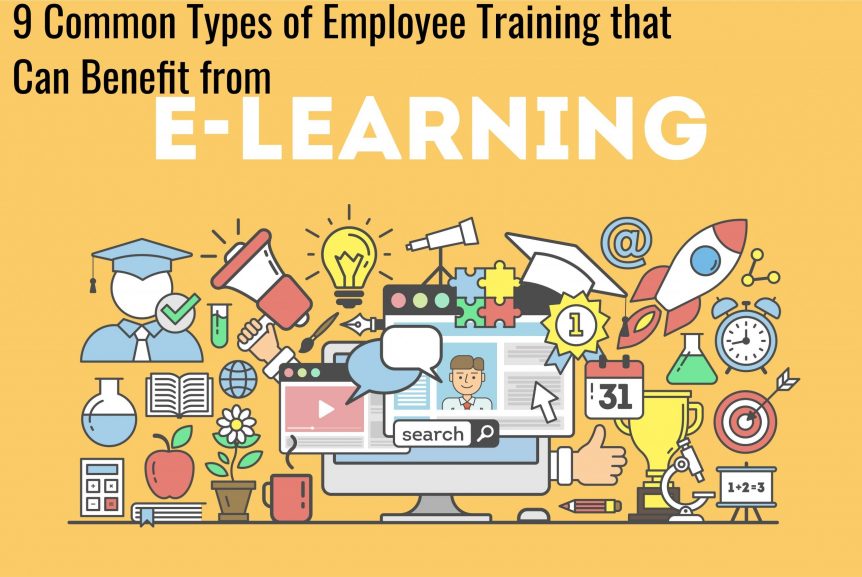9 Common Types of Employee Training that Can Benefit from E-Learning
E-learning brings a range of advantages to the training function in your business. You can reduce costs with e-learning as well as improving training consistency and quality. Ultimately, you can achieve a better return on your investment as well as better results when you incorporate e-learning into your training strategy.
What are the best ways of using e-learning in your business? Here are nine common types of employee training programmes where you should consider using e-learning.
-
Onboarding
The onboarding process can be challenging for both the new recruit and the team that is responsible for training. In many cases, this results in widely different onboarding experiences among new employees, even when those employees are in the same company or department.
Using e-learning makes the process smoother and more consistent, it empowers the new employee, and it gives them confidence as the training is not a one-time thing. With e-learning, the new recruit can always go back over the e-learning course again or refer to it whenever they need to.
-
Technical Skills
You might offer technical skills training to your employees for continuous professional development purposes, to ensure your business has the skills that it will need in the future, and to ensure you remain competitive.
E-learning is the ideal training delivery method for many technical skills topics. Plus, e-learning courses can be quickly and easily distributed and updated.
-
Soft Skills
Soft skills are becoming increasingly important to businesses in Saudi Arabia and the UAE as companies look for staff who can add real value to their operations. The soft skills we are talking about include communication skills, management skills, dispute resolution skills, teamwork skills, and problem-solving skills.
Many of these skills are evergreen, so they don’t change much over time. This fact makes them ideal for e-learning as you can create a library of soft skills e-learning modules that your employees can access.
-
Product Training
Keeping employees up to speed with your products is an ongoing consideration, particularly if you have a large workforce or you are in an industry that regularly adds new or updated products to their range.
E-learning can help with the product training process, plus you can even make the e-learning modules you create available to customers as an additional technical resource.
-
Customer Service
Customer service is an important differentiator between companies in many competitive industries. The standard of service you offer to customers also impacts your bottom line as well as the reputation of your brand. Therefore, continuously improving standards of customer service is essential.
E-learning is ideal for this process of reinforcing and refining existing customer service skills while also teaching employees new skills, methods, and customer service best practices.
-
Business Procedures & Processes
Having established and regularly reviewed and updated procedures and processes is important in any business. However, those procedures and processes are only effective if employees know what they are and how to use them. They are also only effective if employees use them properly.
E-learning can help with all these issues:
- Providing initial training for employees on procedures and processes.
- Providing training when procedures and processes are updated.
- Providing refresher training to ensure procedures and processes are being properly followed.
-
Health & Safety
Some health and safety topics require in-person training, but e-learning can still be of benefit, particularly in the form of supporting or additional material.
You can also use e-learning health and safety training to put employees in realistic scenarios without those scenarios presenting any risks, as they are virtual rather than real.
In other words, there are lots of ways you can use e-learning to improve the delivery of health and safety training in your business.
-
Technology
The use of technology is critical to most businesses and an increasingly wide range of employee roles. However, there are many employees who have a very basic understanding of the apps and platforms that they use, plus they often lack confidence.
There is also often a misconception that this lack of expertise in the use of technology, and lack of confidence, affects mostly older employees. However, it is just as big an issue with younger generations. After all, just because an employee can confidently use social media apps on their phone doesn’t mean they fully understand how to use business applications to create reports, conduct analysis, or deliver a service to customers.
Therefore, it makes sense to provide training to employees on how to use the technology apps and platforms that are most important in your business. E-learning can help with this process.
-
Compliance Training
Compliance training is another area where e-learning offers substantial benefits. With e-learning, you can make sure compliance topics are covered comprehensively and that all employees have a consistent experience.
In addition, creating e-learning courses can make compliance training more engaging and interesting for employees, particularly if you use features like gamification elements, social elements, and scenarios.
Incorporating E-Learning into Your Training Strategy
E-learning won’t be the right delivery method for all types of training that you deliver in your business, but it does offer substantial benefits for a lot of topics. In other words, it is not a case of using e-learning for everything or for nothing at all, as a hybrid approach usually delivers the best results.
The nine types of employee training on this list are a good place to start if you want to expand your use of e-learning, or if your business is new to online training.
